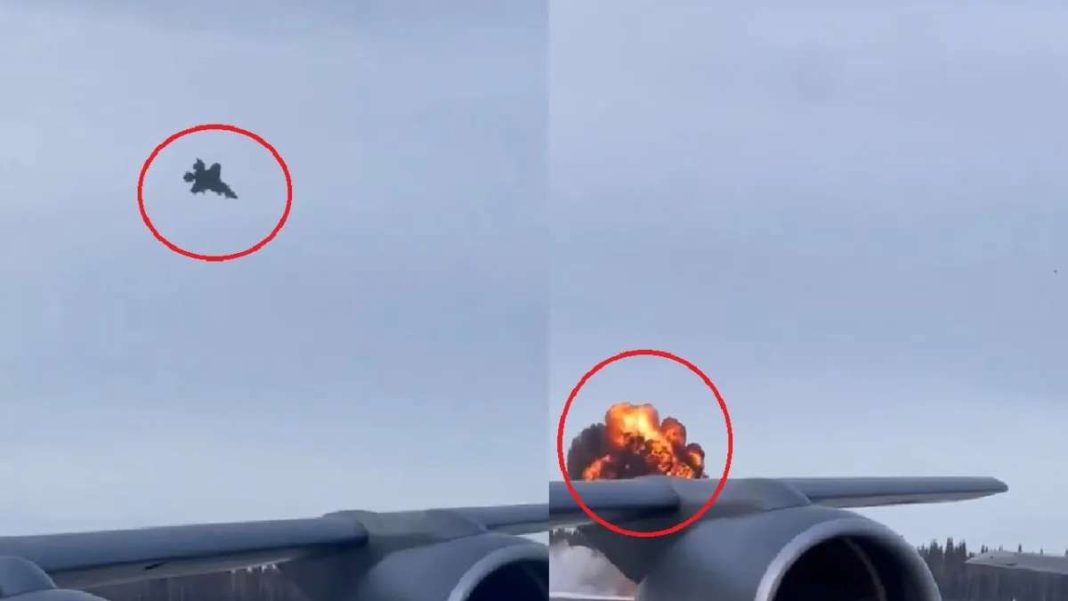An F-35 stealth fighter jet worth around $200 million faced a sudden and unusual problem during a training flight at Eielson Air Force Base in Alaska on January 28. Shortly after takeoff, the pilot noticed that the landing gear was not working properly. The nose wheel became locked at an angle and refused to retract, setting off the chain of events that later led to the F-35 crash.
Trouble in the Skies Before F-35 Crash
This was not just a minor issue. The malfunction triggered the aircraft’s onboard sensors to think it was already on the ground. As a result, the computer system switched into what is known as “automated ground-operation mode.” The jet, however, was still in the air. This switch caused the plane to become uncontrolled and started a risky series of events that ultimately resulted in the F-35 accident.
The temperature that day was around minus 18 degrees Celsius, adding to the severity of the situation. Later checks revealed that the jet’s hydraulic system, which controls key parts like landing gear, had water inside. Once the aircraft took off into freezing air, the water turned into ice. The problem that directly contributed to the F-35 disaster was brought on by this ice jamming the landing gear.
🛩️ Lightning down! U.S. Navy’s elite F-35C fighter jet crashes in California
The 50-Minute Call Before F-35 Crash
As the aircraft circled above the base, the pilot worked through emergency checklists. Realizing the seriousness of the problem, he joined a conference call that lasted almost 50 minutes. On the other end were five engineers from the jet’s manufacturer. The group included specialists in software, safety, and landing systems.
Together, they tried to figure out a way to bring the jet down safely. The engineers suggested performing two “touch-and-go” maneuvers. In this method, the aircraft briefly touches the runway before taking off again, in the hope of resetting or straightening the landing gear.
White House Can’t Save Turkey’s F-35 Access—Congressional Ban Trumps Sanctions Relief
But the attempts made the problem worse. Instead of fixing the locked nose wheel, the maneuvers jammed both of the main landing gears as well. With all three wheels stuck, a normal landing became impossible. The aircraft was now in an even more dangerous position than before, pushing it closer to the F-35 crash.
The company had already issued a maintenance bulletin in 2024, the investigation later noted. That document warned about possible cold-weather issues affecting the aircraft. It specifically mentioned that such problems could make the jet hard to control. Investigators noted that if this guidance had been recalled during the call, the advice to attempt touch-and-go maneuvers might not have been given. Rather, a controlled ejection or scheduled full stop might have been suggested earlier.
A Fiery End on the Runway
Despite every effort, the aircraft continued to spiral out of control. Eventually, the pilot had no option left. Just moments before the jet hit the ground, he ejected from the cockpit. He survived the F-35 crash and suffered only minor, non-life-threatening injuries.
The jet, however, was completely destroyed. It fell onto the runway and exploded into a massive fireball. Video of the F-35 crash quickly spread on social media, showing the fifth-generation fighter tumbling down before bursting into flames. The footage stunned viewers worldwide and gave rise to many theories about what went wrong.
Investigators later confirmed that the core issue was the presence of water in the hydraulic fluid. In the nose and right main gears, water made up almost one-third of the fluid rather than the proper substance. This pollution had come from a hydraulic barrel used to refill the aircraft. The F-35 crashed because the water solidified in the bitter cold, jamming the landing systems and ensuring the aircraft’s demise.
First Italian F-35 deployment from Ämari Air Base intercepts Russian aircraft
The findings of the investigation highlight how something as simple as water in the wrong place can cause a sophisticated aircraft to fail. Despite advanced technology, the jet became uncontrollable once the systems were compromised.
The incident left the runway covered in wreckage, but thanks to the timely ejection, the pilot’s life was spared. The loss of the aircraft, however, marked a major blow, given its enormous cost and advanced capabilities.

